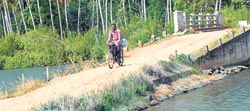
Death of a lagoon and a blow to livelihoodThe Rekawa lagoon is dying and there was no clearer example of the breakdown in the natural system when in March this year, some 2.8 metric tonnes of fish were found dead, literally overnight. The fishermen of Rekawa have been fighting a losing battle for over two decades to try and save their livelihood from a premature death. All to no avail however, as they have now been forced to resort to other means of making ends meet…..for the lagoon can no longer be their provider. As a result of a causeway being built across the lagoon and later a bridge, the free flow of water between the lagoon and the sea has been restricted and as a result, the equilibrium of the lagoon has been adversely affected. Not only has it affected the free flow of water but it has also had a serious impact on the lagoon’s marine life.
Ever since the causeway was built over part of the Rekawa lagoon in 1984, followed by the little bridge that replaced part of the causeway in around 1995, the natural conditions of the canal have not been the same, explains Dr. Bandula Amarasinghe, head of the Department of Limnology, Faculty of Fisheries and Marine Sciences and Technology, University of Ruhuna. However, as most of the causeway was washed away as a result of the tsunami, the lagoon was able to regain its natural status, but, with the reconstruction of the bridge and causeway later on, the lagoon began to suffer again, he added. Before ’84, there were about 45 kraals operating along the banks of the lagoon, which along with the catch from canoes and cast and gill nets, amounted to over 1000 kg of prawns per month. Around 250 families were able to live off this catch. But as the hydrology of the lagoon changed due to the construction of the bridge, the harvest dropped to not more than 25 kg a month, resulting in the gradual collapse of fisheries at the lagoon, he said. The lagoon area spanning over 225 square km gets its fresh water supply via the Kirana and Urubokka Oya and the Pattipola wewa. Usually during the rainy season the lagoon water reaches a critical level, at which point the villagers would cut open the sand bar, allowing the excess water to flow into the sea. As long as the makeshift bridge existed (Edanda) before the causeway was built, 1.5 million cubic metres of water, along with all the debris from the lagoon, washed off to the sea daily. However, once the bridge was built in the mid ’90’s, with 23 (2ft in diameter) hume-pipes running through the lagoon, taking the water to the sea, it took upto two weeks for the lagoon to drain during the rainy season. In addition, the debris and filth too could not be transported through the pipes and thus, remained in the lagoon, gradually making it more shallow. Due to the rate of the water flow being reduced as a result of the pipes, even the reproduction rate of the white shrimps or Kiri Issa (previously found in abundance in the lagoon) that need to be stimulated by the dilution and natural force of the sea water has been affected. Therefore, the shrimps literally face a physical barrier to enter the lagoon now, which has resulted in their near extinction, he explained. The fish in the lagoon had died due to oxygen depletion. With a Government authority’s excessive disposal of solid waste along the main Tangalle-Hambantota road, heavy rainfall caused chemical nutrients such as phosphate and nitrate from the waste to seep into the lagoon causing eutrophication (nutrient pollution). This caused the appearance of a lot of algae leading to the depletion of oxygen which in turn killed the fish, he added. As the natural system breaks down, so does the income of the fisher-folk, said Dr. Amarasinghe adding that then they had to resort to cutting mangroves and burning bricks for survival. “All we want is for the bridge to be reconstructed, using pillars, across the entire 40m stretch of the lagoon, so that the lagoon can return to its former flourishing state,” said W. Karunasena, President of the Rekawa Lagoon Management Authority (RLMA). This lagoon feeds seven surrounding divisions – Madilla, Marakolliya, Madagama, Netholpitiya South, Rekawa East and West and Wellodaya so, it’s not just about the few families that would use the bridge but rather, the hundreds of families that depend on the lagoon for their subsistence, he added. W.K. Premathilaka, a fisherman and member of RLMA says, “Now we’re barely able to make Rs. 100-200 off the day’s catch, which is hardly enough to feed our own family, let alone make a living for ourselves. |
|| Front
Page | News | Editorial | Columns | Sports | Plus | Financial
Times | International | Mirror | TV
Times | Funday
Times || |
| |
Copyright
2007 Wijeya
Newspapers Ltd.Colombo. Sri Lanka. |
